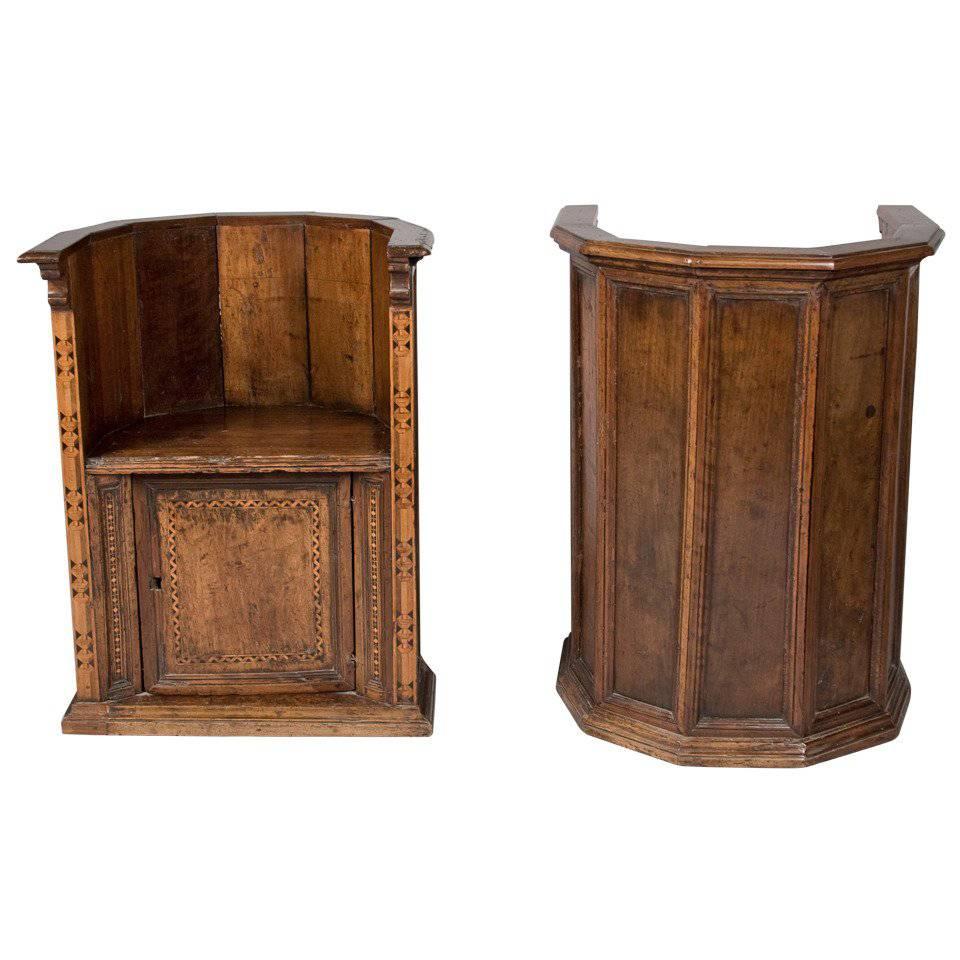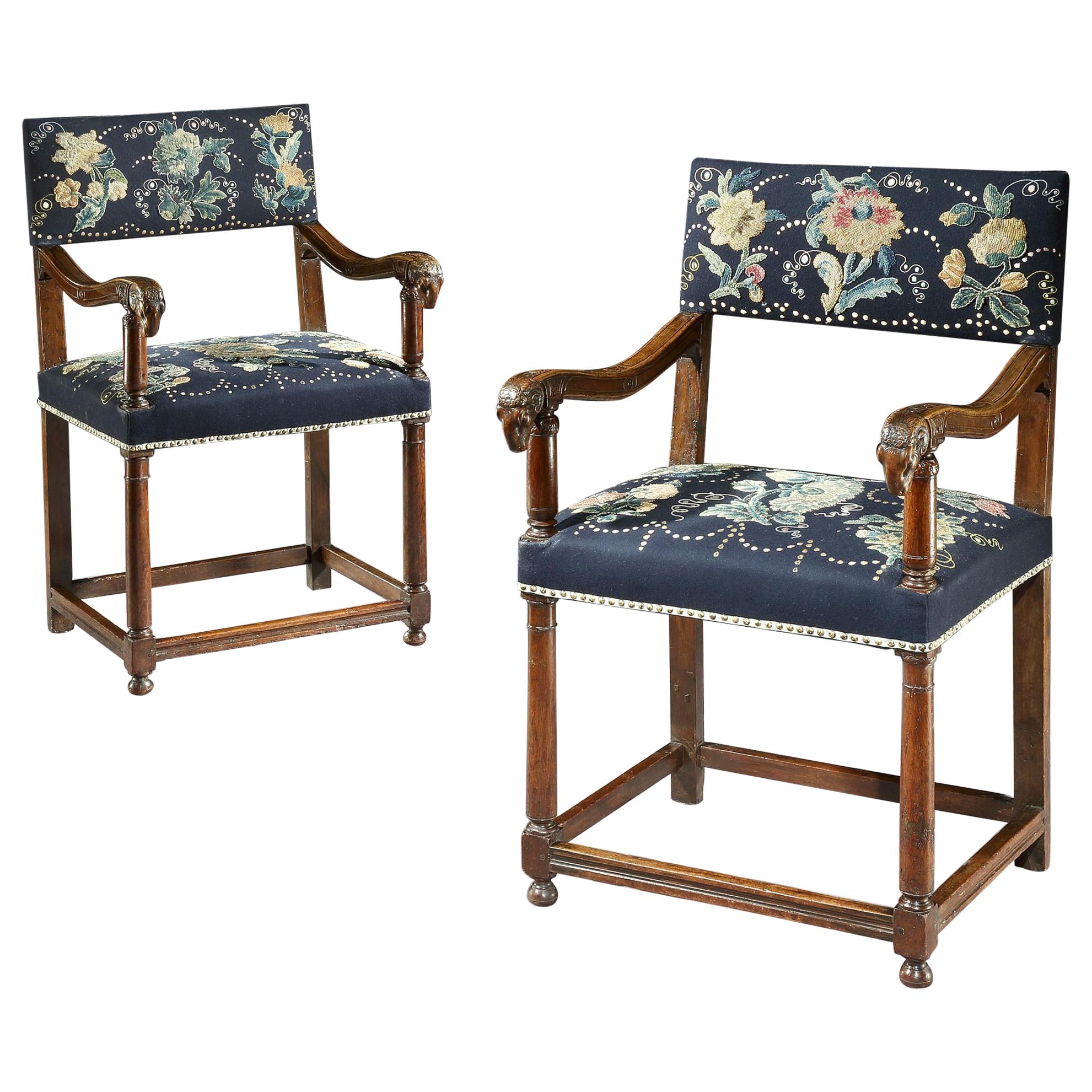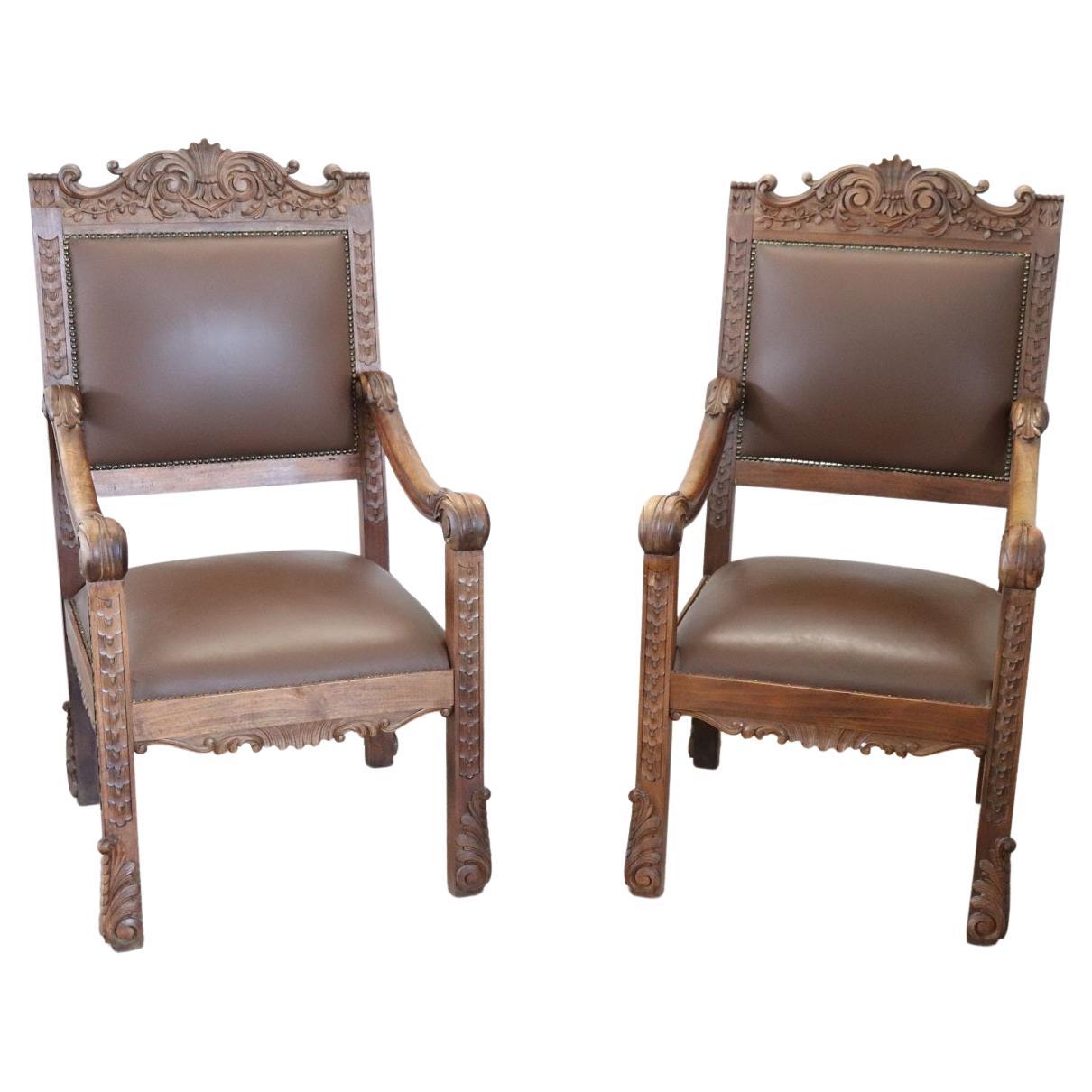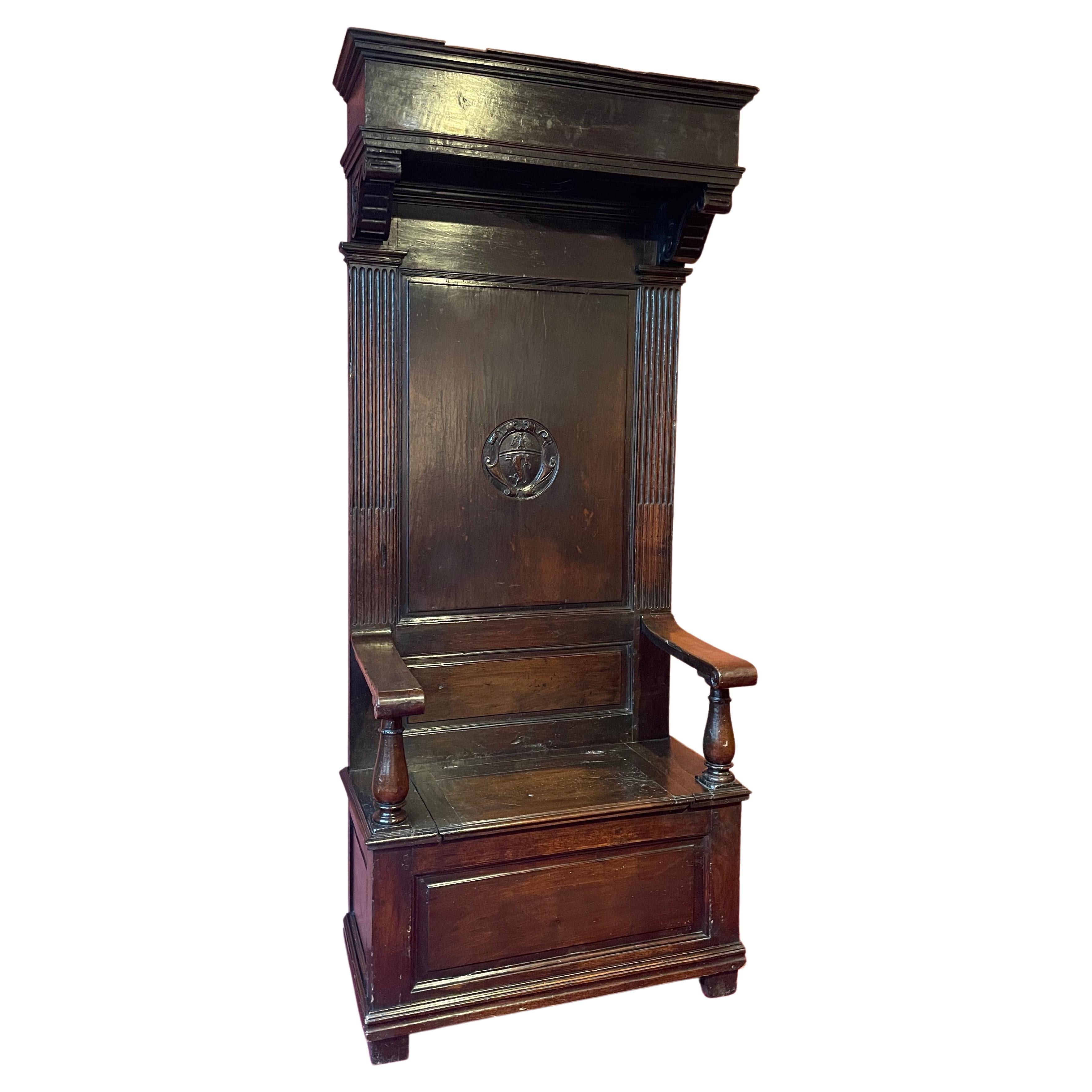Items Similar to Cathedra or Throne Chair, Late 16th Century, French Second Renaissance, Walnut
Want more images or videos?
Request additional images or videos from the seller
1 of 15
Cathedra or Throne Chair, Late 16th Century, French Second Renaissance, Walnut
About the Item
A moulded cornice sits above the high, panelled back with fluting and applied roundels. The later, metal pin on the left edge releases the central, moulded panel in the back which retains its original hinges. When the pin is removed the panel can be lowered, revealing a large area behind. The scroll arms are supported by tapering turnings which can be compared with mid-16th century benches of the nave such as those in the churches in Gerberoy and Coivrel which are in Oise, the Piccardie region of Frances.
The panelled, box seat has later 18th century hinges which reveal a large, compartment and the lock has been removed. The front stiles are decorated with a carved, geometric motif which is derived from architectural design and is found on furniture of this calibre from this epoch. Old worm damage and minor losses. Henri II.
This type of chair was made from the 15th century, and can be seen in the Musee des Arts Decoratifs, and cathedrals in France. This cathedra displays the rigid structure of a chair of honour according to the Gothic system, full panels, high back and hinged box seat but the scroll arms and tapering turnings date it to the Second Renaissance. See No 123 which has similar shaped arms and turnings ; chaire a haut dossier bois de Noyer, France, seconde Renaissance ver 1560-1570, collection privee, (Le Mobilier Francais du Moyen Age a la Renaissance, Jacqueline Boccador).
Measures: Back height 205 cm., 80 ¾ in, seat height 62 cm., 24 ½ in.
Cornice length 75 cm., 29 ½ in. Length 64 cm., 25 in., depth 49 cm., 19 ¼ in.,
Inside panel opening length 46 cm., 18 in., height 84cm., 33 in.,
Provenance: PROVENANCE : Private collection along with a walnut, centre table with slate inset from the same period.
RELATED TO : No 122, cathedre ecritoire, bois de Noyer, Bourgogne, époque Henri II, vers 1560-1570, collection privee, (Le Mobilier Francais du Moyen Age a la Renaissance, Jacqueline Boccador), which also has a hinged back panel. Le mobilier picard 1200-1700, Laurence Fligny, ed Picard, 1990, discusses the benches of the nave in Gerberoy & Coivrel.
Exhibitions: The opening back panel is an ingenious device for concealment as it is not visible from the front or obvious. I only know of one other chair with this feature which is illustrated in Boccador no 122. The original pin was most likely a wooden peg which would appear as part of the structure of the cathedra. When this long, pin is removed the panel can be lowered, revealing a large area behind. We can therefore conclude that this cathedra was made with the intention of concealing and giving access to object/s of great value or importance such as a religious or political iconography which tended to be bound together.
The ‘cathedra’ was originally associated with the Catholic Church where it was reserved as the seat of the Bishop and placed against the wall of the apse of the church. It is possible that this ‘cathedra’ was made for a church or monastery where the panel could have been used to conceal items like documents, charters and relics. However these would have been kept inside a container which would need to stored within a recess in the wall behind. Given that the back is roughly finished with no evidence of being used as a table, does not have any mechanism to support it when lowered and that the hinges are original, I do not think that the secret panel in the chair was conceived with this in mind or that it has been used in this way. If this was the case it would be much easier to move the chair to get access to a box hidden in a recess behind.
There is evidence of such chairs in a secular context where it could have been placed in a private chapel or in the main receiving room serving as a seat of honour for the owner of the house, most likely a nobleman. The restrained ornament on the cathdra also indicates that it is possible it was conceived as a secular piece. It would make more sense that the panel was conceived to hide either a painting or iconography, which could have been religious/political, on the wall behind which was very private and personal to its owner. He may have not needed to see or have regular access to it which is why a support was not made for the panel when lowered and why the original hinges survive. Maybe the fact that he knew it was there as a private manifestion of belief or standing was sufficient. There is archeological evidence in England of religious, wall paintings of similar size which do not bear any relation to the decoration of the rooms they were found in, so it is possible that this occurred in France also. I am in the process of researching this as it is very exciting to be able to produce a piece of furniture that could have been used in this way.
If we look at the context in which this cathedra was made this makes more sense. It was made at the time of the French Wars of Religion (1562–98) which was a period of civil infighting and military operation primarily fought between French Catholics and Protestants. The conflict involved the factional disputes between the aristocratic houses of France, such as the House of Bourbon and House of Guise and both sides received assistance from foreign sources.
Whilst the great majority of the country remained faithful to Catholicism, an important minority joined the Reformation. Coexistence of the two faiths throughout the Kingdom showed itself to be impossible, civil tolerance failed and war was unavoidable. Members of the nobility and even the Royal families converted to Protestantism at different points and led battles against Catholic equivalents. The exact number of wars and their respective dates are the subject of continued debate by historians, some assert that the Edict of Nantes in 1598 concludes the wars, although a resurgence of rebellious activity following this leads some to believe the Peace of Alais in 1629 is the actual conclusion. It was in Nantes, in April 1598, that Henri IV signed the well-known edict putting an end to the wars of religion that had ravaged France for some 36 years. This edict is more complete than the preceding ones. It established a limited civil tolerance and inaugurated religious coexistence. The Reformed service of worship was authorised in all placed where it existed in 1597 and access to all offices was guaranteed to Reformed Protestants.
So it is conceivable that this cathedra was made with a secret, hinged panel in the back to allow its owner, most likely a nobleman, to hide the symbols of his true faith rather than as a piece for the Church itself. Interestingly, Oise which is close to Paris was once home to kings and noblemen who left their mark in the many chateaux, abbeys and cathedrals. The owner of this chair may have been in a position where it was necessary to show his loyalty to Catholicism outwardly but privately his beliefs may have been very different. For example, in England Thomas Howard, 14th Earl of Arundel converted to Anglicanism in 1616 but remained loyal to Rome, the home of his noble family’s religion. Whilst the Cecils associated themselves with the Reformation during their 16th century rise to power, they remained both politically and religiously conservative.
In France, protestants were exposed to harassment and persecution, and certainly hid incriminating objects such as bibles and books of psalms, in all kinds of caches designed for this purpose. They are known to have used mirrors to hide bibles (cf. Musée Desert, Mial, Gard) and the back of paintings, underneath seats, under double/false bottoms, underneath floor boards, and niches carved into the walls as hiding places. Communion coups were carried disassembled in several components. They also printed very small print Bibles called 'Bibles in a bun' that women hid in their hair !
Literature: This Cathedra is an example of excellent craftsmanship executed in walnut. Pieces of furniture, particularly from this period, that were conceived to be objects of disguise and concealment are exceptionally rare, and tend to be in cabinet form. We will never know for sure what the panel was designed to conceal but it is a wonderful evocation of the history, dangers and intrigue of the period in which it was made.
- Dimensions:Height: 80.71 in (205 cm)Width: 29.53 in (75 cm)Depth: 19.3 in (49 cm)
- Style:Renaissance (Of the Period)
- Materials and Techniques:Walnut,Joinery
- Place of Origin:
- Period:
- Date of Manufacture:1550-1600
- Condition:
- Seller Location:BUNGAY, GB
- Reference Number:1stDibs: LU3867315796382
About the Seller
5.0
Vetted Seller
These experienced sellers undergo a comprehensive evaluation by our team of in-house experts.
Established in 1985
1stDibs seller since 2018
84 sales on 1stDibs
Typical response time: 9 hours
- ShippingRetrieving quote...Ships From: BUNGAY, United Kingdom
- Return PolicyA return for this item may be initiated within 7 days of delivery.
More From This SellerView All
- Pair of Walnut Armchairs, Late 16th Century, French Renaissance, with Ram Mask CLocated in BUNGAY, SUFFOLK"This rare pair of upholstered open armchairs relate to examples in museum collections in France, the USA and the UK. Few pieces of Renaissance furniture featuring ram’s head motif arm terminals survive as the chairs would have been in the ownership of the elite symbolising leadership and authority. The condition of these armchairs reflects their age and use and they have a rich colour and lustrous patina. The form of these chairs is characteristic of a stereotypical Renaissance model. The upholstered section of the backs are upholstered in wool with applied 17th century floral needlework faced with gilded studs and supported by square section uprights. The channelled tablet and stylised rosette incised curved arms terminate in acanthus capped carved rams' masks and are supported by column turned uprights headed by an entrelac collar. The ram is a symbol of leadership and authority and it also determination, action, initiative, and Aries, the first sign of the Zodiac. The seats are upholstered in wool with applied 17th century needlework faced with gilded studs and supported by tapering column/ring turned front legs and square section back legs. Some of the stretchers with moulded detailing. Standing on front ball feet. Exceptional original colour and patina. Henri II 1550-60. Condition: The chairs are both sturdy with exceptional colour and patina. One armchair with a splice on the rhs back leg and replaced but period front and lhs stretcher both bearing old nail marks, two other replaced stretchers and the back uprights bearing old nail marks indicating that they were upholstered at some point. The other armchair with an old repair to a break in the right back leg and an old patch near the end of the leg, replaced but period back and lhs stretcher, small patch to bottom of lhs arm where it meets the support. Old worm marks and some losses. Considering the age of the armchairs, these repairs and replacements are not unusual and consistent with the repairs on the related armchairs in museum collections. They suggest that the chairs either fell backwards at some point or someone leant back while sitting in them. Back Height 107cm, 42in, Seat Height 59.5cm, 23½in Width 60cm, 23½ in, Seat 59cm, 23¼in Depth including arm 59cm, 23¼in, Seat 49cm, 19¼in Provenance: Deaccessioned by The National Galleries of Scotland Bearing an old transport label from Alain Moatti (French architect) to Mrs Katz, London Literature: Related to : There are comparable armchairs in international museum collections dated to the second half of the 16th century. Most share the following characteristics with the above pair, the form, the ram's mask carved to the end of each arm, the curvilinear outline of the arm rests, the ring turned front legs as well as the plain square section back legs and plain stretchers. 1. Two stained glass windows...Category
Antique 16th Century French Renaissance Armchairs
MaterialsWalnut
- Cassettone or Bureau-Chest, Late 16th Century, Italian Renaissance, WalnutLocated in BUNGAY, SUFFOLKExceptional museum quality, Italian, renaissance walnut cassettone with fitted bureau in the upper part & exceptional Bambocci carving, Lombardy. This magnificent cassettone exudes the character and quality of the finest, late-Renaissance furniture. Late 16th century, Northern Italian furniture often had the sides, legs or angles, 'a Bambocci', incorporating carved figures which were unique sculptures in their own right. The putti on this cassettone are beautifully carved and of sculptural quality. Each angel has one arm raised to heaven, a poignant touch. Showing customary signs of wear from time, the lion’s paw feet make a great statement. This cassettone was conceived to have visual impact through the quality of the carving, as well as being very practical with the writing compartment fitted in the top part. It has survived in very original condition with a few small repairs and losses, and the color and patina are warm and lustrous. This cassettone was illustrated in one of the seminal works on Lombardy furniture in the 1969 and has been in two renowned collections. The hinged top in two sections faced with a solid moulded edge. The front part has a fall front and opens to reveal a writing compartment. The fall front retains its original lock and is concealed with a false drawer which is above three drawers. All with moulded panels, escutcheons and retaining the original iron handles. The front ends have exceptional, bambocci, carved putti raising their arms to heaven above trailing foliage. Standing on magnificent lion...Category
Antique 16th Century Italian Baroque Furniture
MaterialsWalnut
- Armchair Throne Pair Italian Walnut Red Mohair Velvet Armorial RenaissanceLocated in BUNGAY, SUFFOLKA rare pair of late-Renaissance, Italian, upholstered, walnut, throne, open, armchairs or coppia di seggioloni, retaining their original armorials These throne armchairs are charact...Category
Antique Early 1600s Italian Renaissance Armchairs
MaterialsWalnut
- Table, Drawleaf, 18-Seat, 16th Century, Italian, Renaissance, Walnut, IronLocated in BUNGAY, SUFFOLKThis massive 18-seat table has many features which are typical of drawleaf tables that were made in the last quarter of the 16th century. Early continental drawleaf tables rarely com...Category
Antique 16th Century Italian Renaissance Dining Room Tables
MaterialsWalnut
- Twelve Set Chairs Armchairs Open Fruitwood Upholstered Dining Renaissance-StyleLocated in BUNGAY, SUFFOLKA rare long set of 12, Antiquarian, Renaissance-style, Fruitwood, Upholstered, Open Armchairs - Rare to find a set of 12 of a Renaissance-style armchair, in 35 years of dealing I ...Category
Vintage 1920s French Renaissance Chairs
MaterialsFruitwood
- Armchair, chair, 17th Century, Italian, Walnut, Scroll, Baroque, TapestryLocated in BUNGAY, SUFFOLKThis elegant armchair exudes classic gravitas, with scroll arms, fall turnings and triple toe feet The tapestry back depicting Flora underneath a bower is a distinctive feature. It...Category
Antique 17th Century Italian Baroque Armchairs
MaterialsWalnut
You May Also Like
- Later 16th to Early 17th Century Italian Renaissance Walnut ChairsLocated in San Francisco, CAA pair of Italian Renaissance walnut chairs. Pozzetto, Ref & quot;Volpi Collection- Art Treasures of the Davanzati & quot; These chai...Category
Antique 17th Century Italian Renaissance Armchairs
MaterialsWalnut
- Italian Renaissance Walnut Throne ChairLocated in New York, NY19th century Italian Renaissance style walnut cardinal's throne chair with shell design canopy and column supports.Category
Antique 19th Century Italian Renaissance Armchairs
MaterialsWalnut
- Late 19th Century Italian Renaissance Style Carved Walnut Pair of Throne ChairsLocated in Casale Monferrato, ITImpressive rare pair of throne chairs in perfect Italian Renaissance style, late 19th century. Made of solid walnut wood. The finely carved wooden backrest with very complex decorati...Category
Antique 1880s Italian Renaissance Chairs
MaterialsFaux Leather, Walnut
- Italian Renaissance Style 19th Century Walnut Tapestry Throne ChairLocated in New York, NYItalian Renaissance style (19th Cent) walnut high back column sided throne chair with carved floral design and tapestry upholstery.Category
Antique 19th Century Renaissance Armchairs
MaterialsWalnut
- Northern Italy Renaissance Cathedra with a CanopyLocated in Saint-Ouen, FRThis cathedra or chayère chair is conceived following rules of monumental architecture. The seat can be lift open to reveal a chest. Both curved arm-rests are supported by a baluster...Category
Antique 16th Century Italian Renaissance Armchairs
MaterialsWalnut
- French Renaissance Needlepoint Upholstery Carved Walnut Throne ArmchairLocated in Philadelphia, PA19th century French Renaissance needlepoint upholstery carved walnut throne armchair French Renaissance needlepoint upholstery carved walnut thr...Category
Antique Late 19th Century French Renaissance Armchairs
MaterialsFabric, Walnut
Recently Viewed
View AllMore Ways To Browse
England 16th
Antique Furniture Research
Researching Antique Furniture
Used Throne Chairs
16th Panel
England Renaissance
16th Century Panel
Antique French Documents
Mirrored Armchair
French Calibre
French Renaissance Display
French Renaissance Walnut
Late 16th Century Paintings
Long French Bench
Walnut 16th
16th Century Walnut
French Period Side Chairs
Used Church Seating





